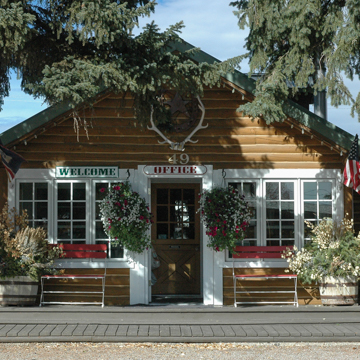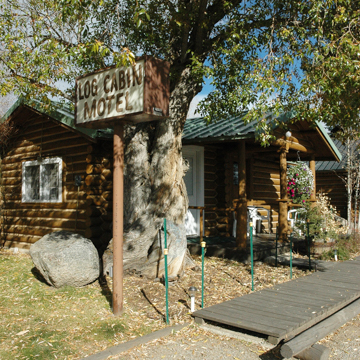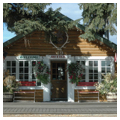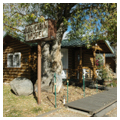You are here
Log Cabin Motel
The Log Cabin Motel in Pinedale was built by local entrepreneur Walter Scott, who owned the Pinedale Cash Store and allowed locals to work off their debt at the store by helping to build the cabins. In 1929 Scott’s venture opened as Camp O’ the Pines, intended to service Pinedale’s growing automobile tourist industry that was spawned by the opening of Highway 191, which connected the Lincoln Highway at Rock Springs with the south entrance of Yellowstone National Park. From the 1920s until the development of the Jonah Field natural gas resources in the early 2000s, Pinedale was a relatively quiet ranching and tourist town, whose primary accommodations were small motor courts like the Log Cabin.
The Log Cabin Motel, along with several other older motels, is located one block east of Pine Street (Highway 191), the main road through Pinedale. Scott designed his motor court in a U-shape, with seven cabins arranged around a main building. The cabins are set back slightly from the road and screened by trees, giving the site a protected and quiet atmosphere. The focal point of the court is the owner’s residence/office, a larger version of the cabins, which occupies the center of the U and fronts on Magnolia Street. The seven tourist cabins are all one-story, two-unit, 25 x 14–foot, saddle-notched log structures with front-gable roofs. A front-gabled porch supported by either white-painted log posts or square wood posts and sheltering two separate entrances is centered on the facade of each cabin. Many of the porch gables, including that of the owner’s residence, are decorated with deer or elk antlers. Parking was originally provided next to the cabins. The cabins were remodeled in the 1930s from two-unit cabins to two-room, one-unit cabins; indoor plumbing was also added at this time. The interiors have been somewhat updated with new fixtures but retain their original rustic feel.
The owner’s residence is also a front-gable log structure, originally built to match the cabins, but is about twice the size, with three rooms instead of two. A separate, board-and-batten–sided bathhouse behind the residence was connected to the building in the 1980s, and remodeled into two additional guest units. A separate clapboard-sided laundry room located between two of the cabins (in the U) was originally built as a garage around 1935.
In addition to tourists, Camp O’ the Pines, which was open year-round and rented cabins by the month, housed Civilian Conservation Corps workers during the New Deal, provided temporary housing for local residents, and offered a place for ranch women to stay when they came to town to give birth. Today, the Log Cabin Motel is one of the few rustic cabin camps still operating in Wyoming.
References
Carlson, Mary Ann, and Rheba Massey, “Log Cabin Motel,” Sublette County, Wyoming. National Register of Historic Places Registration Form, 1993. National Park Service, U.S. Department of the Interior, Washington, D.C.
Liebs, Chester H. Main Street to Miracle Mile: American Roadside Architecture. Boston: Little, Brown and Company, 1985.
Writing Credits
If SAH Archipedia has been useful to you, please consider supporting it.
SAH Archipedia tells the story of the United States through its buildings, landscapes, and cities. This freely available resource empowers the public with authoritative knowledge that deepens their understanding and appreciation of the built environment. But the Society of Architectural Historians, which created SAH Archipedia with University of Virginia Press, needs your support to maintain the high-caliber research, writing, photography, cartography, editing, design, and programming that make SAH Archipedia a trusted online resource available to all who value the history of place, heritage tourism, and learning.




